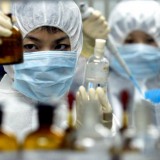Hepatocellular carcinoma accounts for most liver cancers. This type of cancer occurs more often in men than women. It is usually seen in people age 50 or older. In most cases, the cause of liver cancer is scarring of the liver (cirrhosis). Cirrhosis may be caused by:
- Alcohol abuse
- Autoimmune diseases of the liver
- Hepatitis B or C virus infection
- Inflammation of the liver that is long-term (chronic)
- Iron overload in the body (hemochromatosis)
Inflammation, necrosis, fibrosis, and ongoing regeneration characterize the cirrhotic liver and contribute to hepatocellular carcinoma development. The disease processes, which result in malignant transformation (transformed cancer cells are usually undifferentiated and do not have specialized (“mature”) structures or functions. Undifferentiated cancer cells often grow and spread quickly. ), include a variety of pathways, many of which may be modified by external and environmental factors and eventually lead to genetic changes that delay apoptosis and increase cellular proliferation.
Treating malignant tumor through the induction of cell differentiation has been an attractive concept, but clinical development of differentiation-inducing agents to treat malignant tumor, especially for solid tumors has been limited to date.
Interestingly, researchers from Jilin University, China, identified that protopanaxatriol-type saponins are able to induce the differentiation (differentiation is the process by which a less specialized cell becomes a mature and specialized cell type) of liver cancer cells into benign- or normal-looking cells.
The scientists used electron microscope, PCR and other modern technologies to observe the morphological changes of liver cancer cells. Under the influence of protopanaxatriol, the cancer cell growth was dampened, and the malignant appearance of cancer cells became more benign. Moreover, the typical apoptosis changes were also spotted after PPT intervention. For example, the nucleus of the liver cancer cells condensed, mitochondria developed vacuoles, and microvilli decreased as well.
The research results suggest that PPT could be used as an adjuvant chemo drug to change the malignancy of the liver cancer.
The study was published on Journal of Clinical Hepatology














































